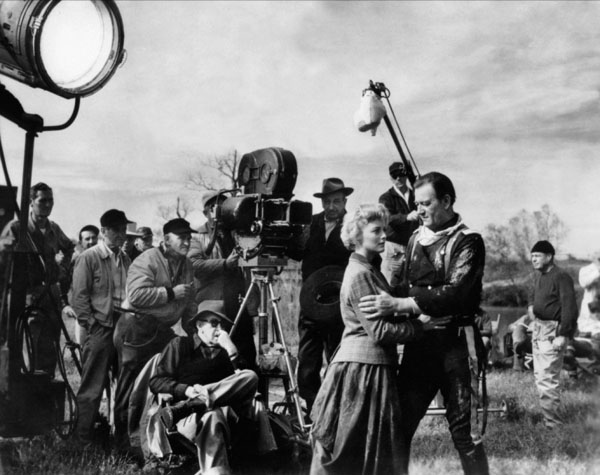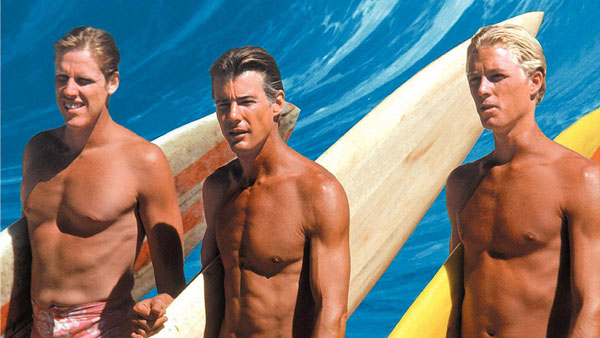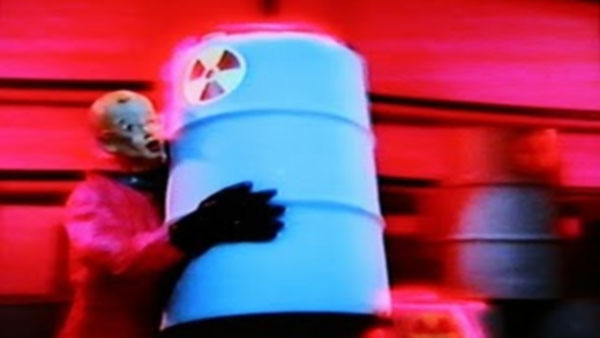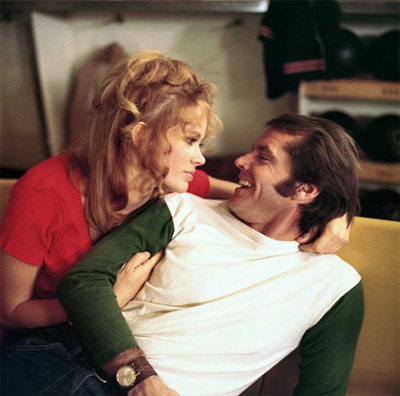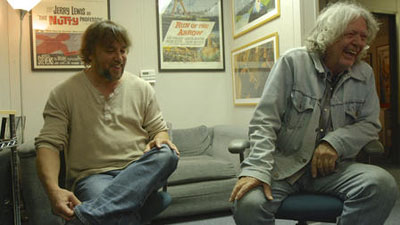The week wraps with two new issues to spend the weekend with. It’s the big Eight-Oh for Bright Lights Film Journal and Before Midnight for Film Comment. We’ll start with the latter. Phillip Lopate‘s piece on Richard Linklater, Julie Delpy, and Ethan Hawke’s third installment in what’s become an accidental trilogy is as fine as you’d expect (and by the way, Dennis Lim interviews the trio for Sunday’s New York Times summer movies special), but first. The must-read of today’s roundup is Kent Jones‘s defense of John Ford. It’s a rebuttal to Quentin Tarantino‘s declaration of hatred for Ford, a rebuttal that pulls QT’s argument apart limb by limb, but also a rebuttal that leaves QT himself respectfully intact. Albeit a few inches shorter.
“From a distance,” writes Jones, “it’s very easy to view the Western genre as a great abstract swirl of cowboys and Indians, the proud Cavalry vs. the mute savages, a long triumphal march of Anglo-Saxon humanity led by John Ford and John Wayne brought to a dead halt by The Sixties. Up close, one movie at a time, the picture is quite different.” And further in, “as Raymond Durgnat might have put it, and as Jonathan Rosenbaum argued so eloquently in his 2004 appreciation of The Sun Shines Bright for Rouge, Ford wasn’t a great artist in spite of the contradictory imperatives of his films but because of them. His films don’t live apart from the shifts in American culture and the demands of the film industry, but in dialogue with them.”
Also in this issue, besides the bonanza of reviews of theatrical and DVD/Blu-ray releases, festival reports and extras, we have, online, Chris Darke on Peter Strickland’s Berbarian Sound Studio and Maitland McDonagh on Peter de Rome, “the ‘grandfather of gay porn,’ whose pioneering shorts and two features unfold at the intersection of art house and smut, products of the moment when softcore sex movies briefly rubbed shoulders with the avant-garde and produced movies like Jack Smith’s Flaming Creatures (63), Kenneth Anger’s Scorpio Rising (63), Andy Warhol’s Blow Job (64), and the Kuchar Brothers’ Hold Me While I’m Naked (66).”
On to Bright Lights, Issue 80, “and just a year shy of its 39th birthday,” as editor Gary Morris notes. He also hints that two essays this time around might evolve into books, John Engle‘s “richly allusive, epic-scale study of the ‘surf film’ genre” and Eddie Selover‘s appreciation of Basil Rathbone. Also, Joe Aisenberg and Tyler Sage weigh in on the Zero Dark Thirty debates, Alan Vanneman takes on Breaking Bad, Girls, and Mad Men, and: “James Young Deer has long been considered the first Native American producer/director, a surprising presence who worked at Bison and Pathé in the early 1910s…. But was he really Native American? In a fascinating investigation, new contributor Angela Aleiss reveals the true story of this curious character’s heritage.”
Plus, of course, the reviews of books and films, including Vlad Dima‘s on Amour, which leads us to…
More reading. Ricky D’Ambrose‘s essay on Michael Haneke for the White Review covers a lot of ground, and in one patch he writes that “the overload of objects and sounds, the strategy of submitting almost every action–a dinner table argument, a suicide, a concert, a murder–to the sharp and shipshape geometry of Haneke’s frame often has the unintended, perverse effect of being pleasurable. This is less the aggressive policy of an administrator of difficulty, or the sobered vision of an ‘old-style modernist’, than the principle of a dandy. If we can amend Baudelaire’s definition, as Camus did in The Rebel, to say that the dandy lives and dies before a mirror, we might also say (again with Camus) that ‘dandyism is a degraded form of asceticism.'”
In the Voice, new chief film critic Stephanie Zacharek and film editor Alan Scherstuhl discuss the question, “What Is a Movie Critic’s Job in the Summer of Comic Books?”
To hear David Edelstein and Tom Shone tell it, documentaries are “incredibly sexy” right now, but Vadim Rizov‘s heard it all before. At Film.com, he suggests that we look at the numbers. Does the success of Justin Bieber: Never Say Never really suggest a resurgence of the genre? “It’s foolish optimism to think hyper-formalist documentaries (where is where really interesting things are occurring now) will have any more commercial success than their strictly fictional components any time soon; right now they don’t even get that.” Counters Daniel Walber: “Addressing a supposed documentary boom with box office data misses the point entirely.”
Luke McKernan has come back from yesterday’s “What is restoration?” conference with a head full of thoughts: “The question is a pertinent one. Film archives have found themselves at a crossroads, as celluloid comes to the end of its commercial life, and digital restoration takes over. Digital is what audiences want, and it is changing how audiences see. Several speakers at the end lamented the bright, flat, synthetic look of some many digital versions of feature films from the past, but what looks (supposedly) good on large screen HD TVs across the sitting rooms of the land is what is determining the aesthetic. For most archives a full restoration means producing 35mm film elements as well as digital outputs, but this is expensive, and in any case is a restoration meant to recover what was seen once in the film’s heyday, or what audiences expect now?”
A.O. Scott on Steven Soderbergh‘s tweeted novella-in-progress: “The style—skeletal tough-guy sentences; cynical asides; pointillistic descriptions; bursts of violence—owes something to Dashiell Hammett, Samuel Beckett and maybe also the French nouveau roman of the ’50s, which specialized in chilly, knowing deployment of familiar narrative codes. But Glue is perhaps best understood as a Soderbergh film carried out by other means. The novella so far is both thrilling, with intimations of sex, danger and treachery, and cerebral, inviting you to admire its craft while also succumbing to its effects. Is it a screenplay in disguise?… Glue is assuredly not, or at least not yet, a movie. But by its author’s own definition you could certainly call it cinema.”
At the Quietus, Anthony Nield revisits Human Highway, the 1982 movie Neil Young made with Russ Tamblyn, Dean Stockwell, Dennis Hopper, Sally Kirkland, Devo… “By 1980, and to the tune of almost $3 million, Young had created a massive set on which to film his tale and the barest outline of a plot. He would play Lionel, a simple-minded garage attendant who dreams of becoming a big time rock ‘n’ roll star…. ‘Think Jerry Lewis,’ is Young’s instruction in [his autobiography] Waging Heavy Peace when it comes to describing Lionel. He’s also cited The Wizard of Oz and Japanese Kaiju (giant monster) movies as an influence. They somehow conflate into a Day-Glo vision of Americana that’s oddly timeless.”
PopMatters is running an excerpt from Thomas Doherty‘s new book, Hollywood and Hitler, 1933-1939.
In the new Believer, Kathryn Borel interviews Rashida Jones and Greg Cwik writes, “If Hawks’s Big Sleep is the archetypal faithful Marlowe film, Altman’s adaptation of The Long Goodbye is the archetypal modification: characteristically syncopated and opaque, both satire and homage, poison love letter to a genre and inside joke to its enthusiasts.”
Jonathan Rosenbaum has posted his previously unpublished 1999 profile of Albert Brooks.
Jim Knipfel looks back on Tod Browning’s The Unholy Three (1925) and Jack Conway’s 1930 remake. Also at the Chiseler, Imogen Smith on Joan Blondell.
Dolby Atmos is “a new cinema sound system that promises to change the way you see and hear movies. Does it?” A guest post at David Bordwell and Kristin Thompson’s place from film scholar Jeff Smith.
New York. Martina Kudláček‘s Fragments of Kubelka is screening at Anthology Film Archives, and Michael Sicinski calls it a “relaxed, ambling documentary” here in Keyframe. For more, see Michael Atkinson in the Voice and Michael Metzger‘s essay for Idiom, in which he writes that “though Mekas found something crystalline and organic in their compressed imagery, Kubelka’s classic works from the fifties and sixties strike me as elegantly, delicately artificial; clockwork-like, reflecting Kubelka’s enthusiasm for the lost art of the handmade timepiece.”
For Paper, Angelo Pitillo talks with Karen Black, “currently the subject of a Nitehawk Cinema retrospective, which features six of her classic outings: Easy Rider, Five Easy Pieces, Burnt Offerings, The Day of the Locust, Family Plot (Alfred Hitchcock’s final film) and the campy cult classic, Airport 1975.”
And how’s this for a great idea for a series: Booed at Cannes. It’s running at BAMcinématek from May 8 through 23 and David Reilly elaborates on the general concept at BAM’s blog.
Los Angeles. “The Los Angeles Asian Pacific Film Festival, the largest such event in Southern California, is now in its 29th year, and its lineup of films from more than 20 countries is, as always, a mixed bag of talent, intentions and indie spunk.” It’s on through May 12, and Doug Cummings previews four titles in the Weekly.
Meantime, the Los Angeles Film Festival, running from June 13 through 23, has announced its full lineup of “nearly 200 feature films, shorts and music videos from more than 40 countries.”
London. In a fantastic piece for Sight & Sound, Pasquale Iannone notes that “much of the writing on neorealism (not only that in English) has tended to work with a restricted filmography of a dozen or so titles, focusing almost exclusively on the canonical trio of Rossellini, De Sica and Visconti.” What’s more, “even after seven decades of debates on the subject, in-depth studies of the trend’s origins are surprisingly few. We know more about neorealism’s own legacy than we do about some of the films that helped shape it in the first place.” And he reexamines those forerunners; clips abound. Sight & Sound Deep Focus: The Roots of Neorealism is on through June 6 at BFI, and on Tuesday, Pasquale Iannone will host a panel discussion.
In the works. Richard Linklater and James Benning have known each other since the mid-80’s, and Cinéma, de notre temps: James Benning and Richard Linklater is currently in post. “Working with legendary producer André S. Labarthe—who co-created the long-running French television series Cinéma, de notre temps (Cinema of Our Time)—the critic, teacher, and curator Gabe Klinger set out to document the unique friendship of Benning and Linklater over the course of a few days in Austin and Bastrop, Texas, while the two filmmakers presented Benning’s films at the Austin Film Society, played baseball at Linklater’s home, visited old shooting locations, and talked about their respective filmmaking trajectories over long meals and hikes.”
“Now that Steven Spielberg is free from the shackles of Robopocalypse—a terribly titled sci-fi action flick that is basically all but dead—he is moving on to other projects,” reports the Atlantic Wire‘s Richard Lawson. “Next up is American Sniper, based on the autobiography by Chris Kyle, a prolific Navy SEAL sniper (160 confirmed kills) who was shot to death by a friend while on a shooting range in February of this year.” Bradley Cooper will play Kyle.
Deadline‘s Mike Fleming Jr. reports that Tate Taylor, “who launched his writing and directing career by getting the option on The Help before author Kathryn Stockett was done writing it, has gotten himself on the ground floor of another sure-fire bestseller. Taylor has been granted an option by Stephen King to adapt and direct Joyland, the King novel that will be published in June…. Set in a small-town North Carolina amusement park in 1973, Joyland tells the story of a college student who moonlights as a carnival worker. There, he confronts the legacy of a vicious murder, the fate of a dying child, and the ways both will forever change his life.”
For news and tips throughout the day every day, follow @KeyframeDaily on Twitter and/or the RSS feed. Get Keyframe Daily in your inbox by signing in at fandor.com/daily.

